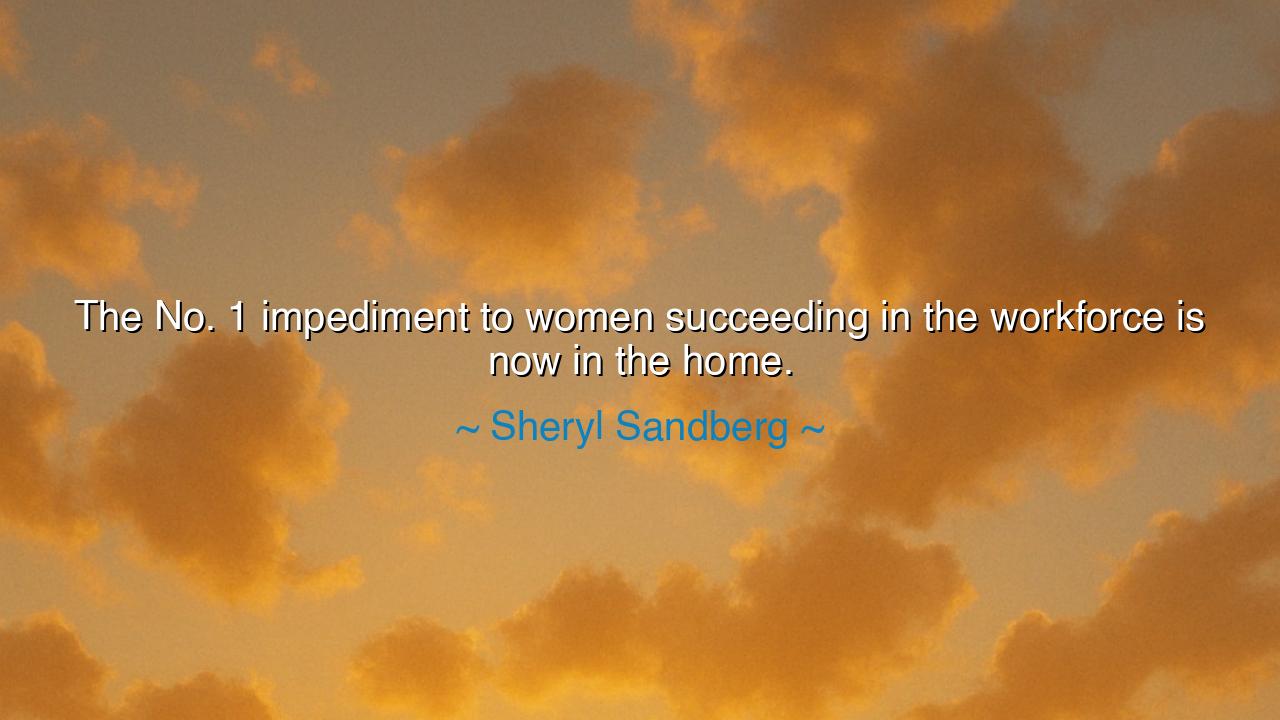
The No. 1 impediment to women succeeding in the workforce is now






There are some truths that strike like thunder—not because they are new, but because they name aloud what has long been silently endured. Such is the wisdom in Sheryl Sandberg’s bold declaration: “The No. 1 impediment to women succeeding in the workforce is now in the home.” Beneath these words lies not condemnation, but revelation—a recognition that while walls of law and policy may have fallen, unseen chains still linger within the private sphere. Sandberg, a modern leader of industry and thought, speaks not only to the labor of the marketplace, but to the invisible labor of the household—the burdens of care, expectation, and emotional management that too often rest unequally upon the shoulders of women.
In ancient times, the home was revered as the hearth, the sacred center of life. Yet it was also a place of confinement, where women were tasked not only with sustaining the body, but preserving the illusions of harmony and selflessness. The ancients told tales of noble queens and wise wives—Penelope weaving and unweaving her tapestry while waiting for Odysseus, her intelligence confined to domestic patience rather than public power. Even today, in an age that proclaims equality, the echoes of that division remain. Women have entered the halls of power, but their journey is still shadowed by unspoken expectations—that the home, no matter how modern, is theirs to carry.
What Sandberg names is the hidden barrier, the quiet war waged behind closed doors. For while the workplace may have opened its doors, the burden of domestic labor—raising children, maintaining order, tending to emotional needs—has not yet been evenly shared. A woman may lead a company, but she is often still expected to lead the household as well. The duality is exhausting, not only physically but spiritually. Her quote stands as both diagnosis and challenge: that true equality will not come from offices or laws alone, but from the transformation of the home itself—from partnership replacing hierarchy, from shared duty replacing silent sacrifice.
Consider the story of Emmeline Pankhurst, the great suffragette who fought to win women the right to vote. Her battle was not only with the parliament of men, but also with the ideology of the home—the belief that a woman’s virtue lay solely in service and submission. When Pankhurst chose activism over domestic obedience, she was condemned as unnatural. Yet her rebellion was not against family or motherhood, but against the belief that family required her silence. Like Sandberg, she understood that the home, when bound by tradition rather than love, can become the most subtle cage of all.
Sandberg’s words also remind us that progress is not measured by access alone, but by freedom of balance. To succeed in the workforce, a woman must not only have opportunity—she must have support. True equality demands that men too learn the sacred art of nurturing, that care and leadership be seen not as feminine virtues but as human ones. The home, then, must evolve from a place of division to one of shared stewardship. The old order—where one worked and the other served—belongs to the past. The new home must be a partnership where both contribute to creation, both share in care, and both rest in peace.
This, too, is the essence of ancient wisdom. The Chinese philosopher Lao Tzu taught that balance is the highest form of power—that the yin and yang, the feminine and masculine, must coexist in harmony for life to flourish. So it is in the home: where imbalance breeds exhaustion and resentment, balance restores joy and strength. For when women are freed from invisible labor, and men are freed from the narrowness of domination, both rise together. Society itself becomes more whole, its labor more just, its love more real.
Thus, the teaching of Sheryl Sandberg’s quote is both modern and eternal: true liberation begins at the hearth. Let no partnership be built on unspoken servitude, nor love on unequal sacrifice. Let men and women together dismantle the quiet injustices that dwell beneath the roof. Let children grow in homes where respect flows both ways, and where success is measured not by who earns or who serves, but by the peace shared among all.
So, to all who listen: begin your revolution not in the streets, but in your own house. Speak openly, share equally, live consciously. For until the labor of the heart is divided with fairness, the labor of the world will remain unjust. And when the home at last becomes a place of balance, partnership, and mutual respect, then the world itself will follow—and both man and woman will finally stand side by side, not only in work, but in worth.






AAdministratorAdministrator
Welcome, honored guests. Please leave a comment, we will respond soon